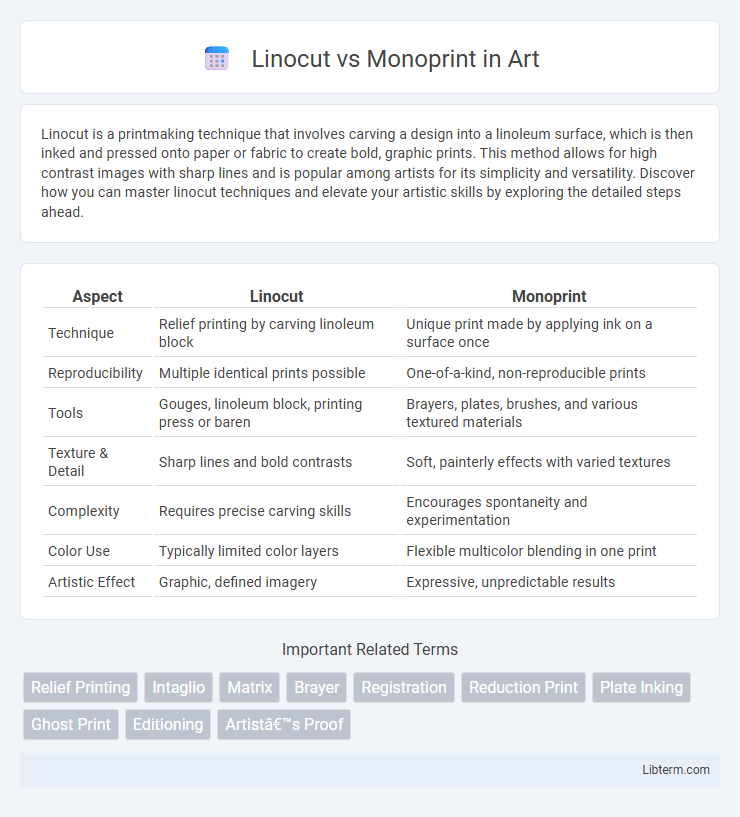Linocut is a printmaking technique that involves carving a design into a linoleum surface, which is then inked and pressed onto paper or fabric to create bold, graphic prints. This method allows for high contrast images with sharp lines and is popular among artists for its simplicity and versatility. Discover how you can master linocut techniques and elevate your artistic skills by exploring the detailed steps ahead.
Table of Comparison
| Aspect | Linocut | Monoprint |
|---|---|---|
| Technique | Relief printing by carving linoleum block | Unique print made by applying ink on a surface once |
| Reproducibility | Multiple identical prints possible | One-of-a-kind, non-reproducible prints |
| Tools | Gouges, linoleum block, printing press or baren | Brayers, plates, brushes, and various textured materials |
| Texture & Detail | Sharp lines and bold contrasts | Soft, painterly effects with varied textures |
| Complexity | Requires precise carving skills | Encourages spontaneity and experimentation |
| Color Use | Typically limited color layers | Flexible multicolor blending in one print |
| Artistic Effect | Graphic, defined imagery | Expressive, unpredictable results |
Introduction to Printmaking Techniques
Linocut and monoprint are distinct printmaking techniques used to create unique artistic impressions. Linocut involves carving a design into a linoleum surface, which is then inked and pressed onto paper, producing sharp, repeatable prints with bold lines. Monoprint, in contrast, is a more spontaneous process where ink or paint is applied directly to a smooth surface and transferred to paper, resulting in one-of-a-kind, textured images that cannot be exactly replicated.
What is Linocut Printing?
Linocut printing is a relief printmaking technique where artists carve a design into a linoleum sheet, removing the non-printing areas to create a raised image. Ink is applied to the uncarved surface with a roller, then pressed onto paper or fabric to transfer the design. This method produces crisp, bold lines and is ideal for producing multiple copies of the same artwork.
What is Monoprinting?
Monoprinting is a unique printmaking technique where artists create a single, one-of-a-kind impression by applying ink or paint onto a smooth surface such as glass, metal, or acrylic before transferring it onto paper or fabric. Unlike linocut, which involves carving a design into linoleum to produce multiple consistent prints, monoprinting emphasizes spontaneity and variation, allowing for different effects with each impression. This method is valued for its versatility and ability to produce rich textures, blending painting and printmaking elements in one distinctive image.
Key Differences Between Linocut and Monoprint
Linocut involves carving a design into a linoleum block to create a repeatable print, characterized by crisp lines and distinct shapes. Monoprint produces a unique, one-of-a-kind image by manipulating ink on a smooth surface, offering more painterly and spontaneous effects. Key differences include the reproducibility of linocuts versus the singularity of monoprints, as well as the level of detail achievable through carving compared to the fluidity of ink application.
Materials and Tools Required
Linocut requires linoleum blocks, carving tools with various blade shapes, and oil-based or water-based printing inks. Monoprint uses a smooth plate such as plexiglass or metal, printing inks or paints that can be manipulated on the plate, and brayers or brushes for application. Both techniques benefit from printing presses or barens to transfer the ink onto paper, but linocut demands more specialized carving equipment while monoprint emphasizes surface preparation and ink manipulation tools.
Artistic Process: Linocut Step-by-Step
Linocut begins with carving a design into a linoleum block using gouges, removing areas meant to remain white in the final print. Ink is applied evenly to the raised surfaces of the carved block, which is then pressed onto paper or fabric to create the print. This relief printing process allows artists to achieve sharp lines and bold contrasts, distinguishing it from the more fluid and unique impressions of monoprints.
Artistic Process: Monoprint Step-by-Step
Monoprinting begins with preparing a smooth printing plate where ink is applied directly using brushes or rollers, allowing for spontaneous and unique designs. Artists manipulate the ink on the plate through various techniques such as scratching, wiping, or adding textures before pressing paper onto the surface for a single impression. This process emphasizes unpredictability and individuality in each print, contrasting with the more controlled carving and repeated impressions characteristic of linocut.
Visual Styles and Effects Comparison
Linocut produces bold, sharp contrasts with clean, repetitive lines ideal for graphic, high-contrast images, emphasizing texture through carved linoleum surfaces. Monoprint offers unique, one-of-a-kind prints characterized by fluid, painterly effects and varied textures that cannot be precisely replicated, often showcasing softer edges and dynamic blends of ink. Linocut excels in strong linear patterns and consistent impressions, while monoprint emphasizes spontaneity and unpredictable visual richness.
Pros and Cons: Linocut vs Monoprint
Linocut offers precise, repeatable prints with clear, bold lines, making it ideal for detailed designs and multiple copies, but it requires carving tools and can be time-consuming. Monoprint provides unique, one-of-a-kind prints with more spontaneous textures and layering opportunities, though it lacks reproducibility and can be less predictable in results. Both techniques cater to different artistic goals: linocut excels in controlled repetition, while monoprint thrives on singular, expressive variations.
Choosing the Right Printmaking Method for Your Art
Linocut and monoprint offer distinct techniques suited for different artistic goals: linocut involves carving a design into linoleum to create bold, repeatable prints with clean lines, ideal for precise imagery and multiple copies. Monoprint produces a single, unique impression by painting or inking directly onto a smooth surface, perfect for spontaneous, expressive artworks with varied textures. Selecting between linocut and monoprint depends on whether you prioritize reproducibility and sharp contrast or uniqueness and fluidity in your printmaking process.
Linocut Infographic

 libterm.com
libterm.com